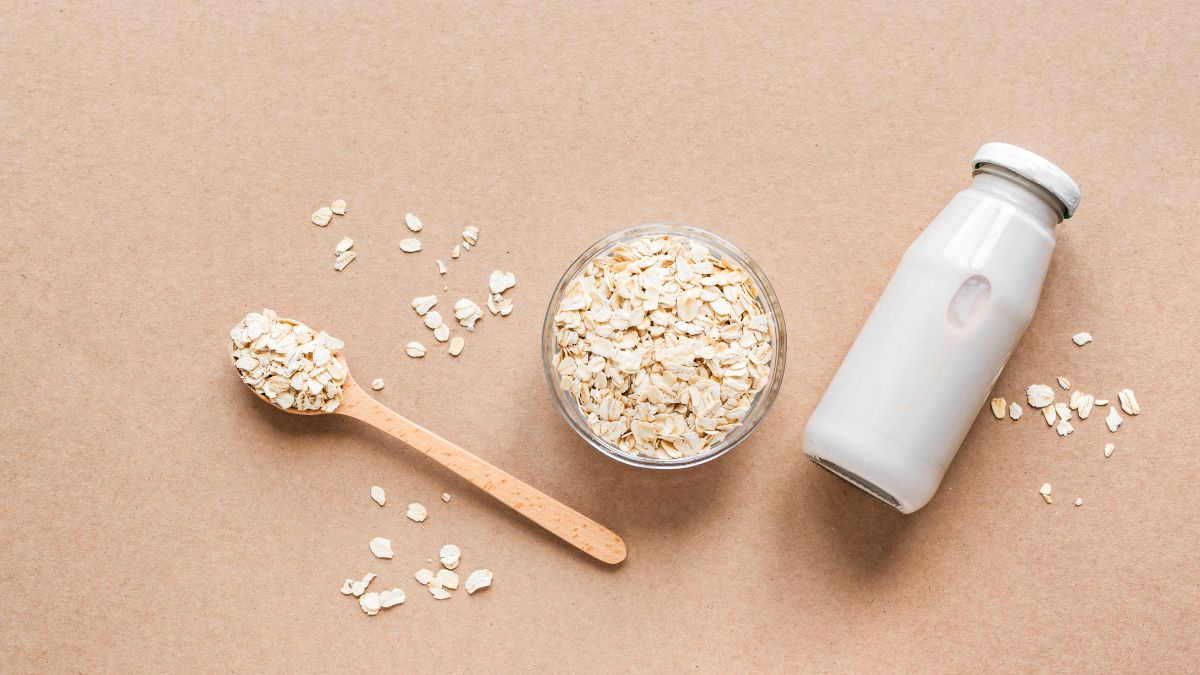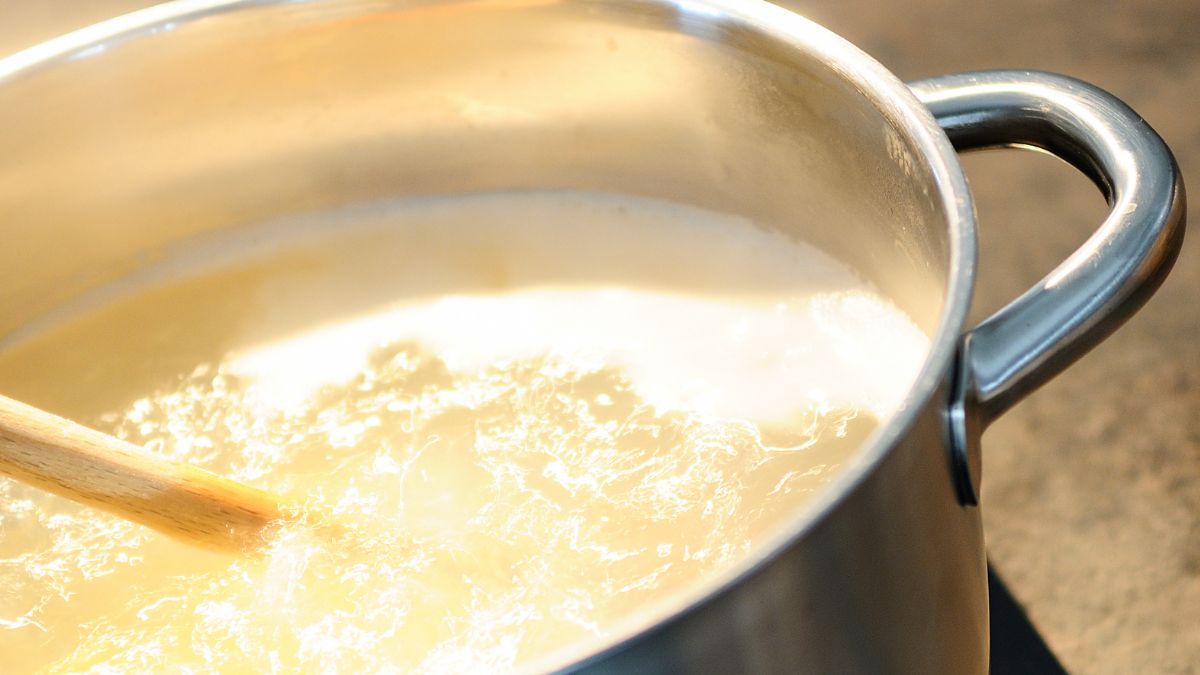Here’s How to Warm up Oat Milk! [5 Methods Explained]

Oat milk is a great alternative for those prone to allergies as it’s non-dairy, nut-free, and (almost always) gluten-free. Even though I don’t have such issues, it’s still my favorite addition to a cup of coffee because of its creaminess. Oat milk is a superb choice for a late-night drink, as an addition to your breakfast granola, and even in baked goods. But it’s even better warm. So, you’re probably asking yourself, “Can you boil oat milk?”
You can simmer oat milk, but never vigorously boil it, though. Still, you can prepare any food, from gravies to cookies, without messing up its texture. Just handle it cautiously, as it has a tendency to curdle, dense up, and change its flavor. You can heat it on the stove, in the microwave, and even steam it!
Oat milk recently became one of my favorite additions to coffee and hot chocolate, but the first time I made a creamy sauce with it changed my life – I never want to go back on using anything else! If you love the oaty flavor as I do, try to incorporate it into as many meals as you can. Using the tips and tricks below, you won’t have any trouble doing so. Read on to get all the answers, plus some reheating tips to make your life easier!
Is It Okay to Boil Oat Milk?
Depending on what you want to use it for, you definitely can. If you’re planning on drinking it, then skip the boiling part. There are three reasons for this: change in its consistency, its taste, and reduction of nutrients. [1]
Cooking decreases protein levels, plus all the key vitamins in oat milk: vitamins B12, A, D, riboflavin, and the mineral calcium. Also, boiling can cause sugars in it to caramelize and burn, which leads to an unpleasant flavor.
Still, if you have to cook it, simmer it, never bring it to a rolling boil, as it will curdle and separate.
How to Reheat Oat Milk?
The trick is to do it gently, don’t rush! The ideal temperature for oat milk is between 150°F and 160°F, so if you have a thermometer, put it to good use.
On the Stove
Whisking regularly and heating it on the low is the key. Plus, always opt for thick-bottomed pots as they warm slower, and you’ll have more control over them. Oat milk tends to form a thick layer on the bottom if hit with a heat wave suddenly.
This also means you have to whisk it constantly if using a thin-bottomed pan and every 15-20 seconds for a thick-bottom pan. Whisking will prevent condensation and sticking whatsoever. You may be tempted to turn the heat up, but don’t do it if you want to preserve the texture.
Be patient and keep it on the low. Just a heads up, always pour cold milk into a cold pot, as you’re risking curdling by exposing the dish to the heat first, even for a bit. Heat up the milk below the boiling point for the best results.
So, when you see it steaming and when bubbles appear on the rim of the pot, it’s done. Don’t bring it to a rolling boil at all!
In the Microwave
The first step is adapting your microwave to medium power. It’s important because high temperatures will cause milk to curdle. Keep in mind not to overfill your glass or container, as you’ll have to stir it a few times.
Heat it up in short intervals to avoid overheating, for 15 seconds each. Also, after each interval, mix it up to avoid heat pockets that tend to form while microwaving. Plus, it’s not strange for proteins to form a thin film on the surface, so that’s one more reason to stir it.
3-4 intervals will be more than enough to reach the desired temperature, just don’t let it boil.
In the Double Boiler
The double boiler method is always the best option. It is gentle enough to not worry about burning the milk at all. But still, you’ll have to stir it here and there as it could form a skin over the surface.
It’s almost impossible for milk to curdle when heating like this because you’re heating it over the steam. When the milk starts to steam, and bubbles appear on the edges – it’s done! You can use a simple pot filled with water and put a bowl of milk over it if you don’t have a double boiler.
In Hot Water
This is a handy option to serve tepid milk, ideal for drinking. Just pour boiling water into one dish and place another dish filled with oat milk in. Heated that way, it can’t thicken, lose its nutrients, or change the flavor.
With a Steamer
This is the method for barista oat milk only. The process is the same as steaming regular milk, as it will form a frothy layer without coagulating or getting slimy. Still, you need to steam it at the optimal temperature for oat milk, which is approximately 150°F.
Does Oat Milk Thicken When Heated?

There are many different varieties of oat milk: from 100% homemade to store-bought packed with additives. Now, those additives aren’t always as bad as we would expect them to be. Almost all commercial milk labels you see on the shelves contain stabilizers, and you can treat them almost the same as regular milk.
Another extremely important thing is that oats are a mucilaginous ingredient which means they are naturally slimy. So, when you boil oat milk, it will become viscous and have a gooey mouth feel because heat activates it. This stands for homemade milk only due to pasteurization in the industrial process, and here’s why.
The mucilage is a type of fiber comprised of large, complex sugar molecules which break into smaller, simple molecules recognizable as glucose. Those fibers tear apart, making the milk unable to dense up and naturally sugary. To conclude, there are varieties that won’t be denser, so you can heat them without any worry at all.
When it comes to homemade oat milk, different principles apply here, though. Making oat milk at home is a simple task, so it’s no surprise that many people do it. The fact is it will thicken when heated, and there’s a very good reason for it.
When straining blended oat milk through a sieve or even gauze, small particles of residual oats will still be in the liquid. So, when heated recklessly or brought to a boiling point, those mucilage bits will activate, bulge, and increase the viscosity of the milk. You’ll be left with a slimy and possibly grainy texture.
This works better than amazing in some meals that require creamy, velvety consistency like custards, sauces, creamy soups, gravies, bechamel, hot chocolate, desserts like panna cotta, different mouses, and so on. It will dense up naturally into a silky and smooth mixture without any additions at all, just whisking.
Also, there is a hack to prevent thickening even in the homemade oat-based beverage. Adding a splash of oil, whether coconut, grapeseed or any other you like, will do the trick.
Can You Reheat Oat Milk Twice?
This is a definite no – just to be safe! Let’s dig into some scientific facts to justify this straight NO. As said above, when heated, large sugar molecules break into smaller ones that are responsible for a light sweet taste. Hence, heating it again causes the remaining sugar to burn, leaving you with bitter-tasted milk.
In the end, the signature subtle sugary taste of oat milk is replaced with a sharp, burnt flavor. Likewise, it can become grainy and far from that silky texture everyone expects. On a more important note, lukewarm milk is a pretty breeding ground for bacteria.
So, when you let the milk cool one time and heat it up again, you’re risking the digestion of bacteria, especially if someone drank from it. Plus, nutritional values will significantly drop when you expose it to heat multiple times.
Can You Heat Up Oat Milk for Hot Chocolate?
Yes, and the best option is to use some of the methods listed above. Gently simmering is the only option here, as that’s the way to compact, creamy hot chocolate that won’t curdle. Along with whisking it constantly, you’ll get silky smooth and trés delicious hot chocolate.
If you fancy a bit thicker, more pudding-like choco, simply simmer it longer until you’re satisfied with its consistency. Your beverage will have a distinct oat relish that compliments cocoa flavor flawlessly, plus goes along finely with vanilla, honey, cinnamon, mint, and so on. It will actually have better consistency than chocolate with regular milk as it naturally has a thickening agent – mucilage.
This means you don’t need to add cornstarch, pudding powder, or any other ingredient to dense it up, still, you’ll get extra creamy hot chocolate. Yum!
Can You Heat Up Oat Milk for Coffee?

Sure, you can. The best to use here are barista varieties, as they are made for steaming purposes. Still, you can use regular oat milk, and here’s how! Keep in mind to always heat up your milk a bit, never add cold milk to hot coffee since it will undoubtedly curdle.
The reason for this is a huge temperature difference, plus the acidity of the coffee. So if you’re pouring coffee in 100% homemade oat milk with no stabilizers, make sure your coffee is not too strong. There are actually coffee labels that pair with oat milk impeccably.
Pro tip: Try to pour coffee into the milk, not vice versa, so you kick it off gently.
Can You Freeze Oat Milk?
You can undoubtedly freeze oat milk, preferably in an airtight container, but you shouldn’t keep it frozen for more than 3 months, though. Slowly defrosting it is the only way to go, and the best is to leave it in the fridge overnight – never at room temperature. Make sure to use it in the next 3 days after thawing for safety reasons.
Don’t be surprised if the texture isn’t smooth but grainy. It’s not spoiled, just strain it! Plus, it can separate as well, so it’s better to use it in everything else except drinking it solo. Don’t forget to shake it well!
